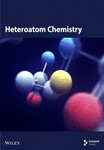Synthesis, characterization, and computational study of some new organotellurium compounds containing azomethine groups
Abstract
The reaction of ortho-mercurated anilines with benzaldehyde gave the ortho-mercurated Schiff bases. The reaction of the mercurated Schiff bases with tellurium tetrabromide in 1:1 and 2:1 mole ratio using dry chloroform as solvent gave the ortho-tellurated Schiff bases compounds ArTeBr3 and Ar2TeBr2, respectively, in good yields (where Ar = 5-ClC6H3N=CHC6H5, 5-BrC6H3N=CHC6H5, 5-CH3OC6H3N=CHC6H5, and 5-NO2C6H3N=CHC6H5). The reduction of ArTeBr3 by hydrazine hydrate gave the corresponding ditelluride (i.e., Ar2Te2). Treatment of Ar2TeBr2 with hydrazine hydrate afforded tellurides (Ar2Te) in good yields. Attempts to prepare the corresponding aryl tellurenyl bromides, ArTeBr, by partial reduction of ArTeBr3 with various reducing agents were unsuccessful. All these new compounds were characterized by microanalysis, 1H, and 13C NMR, IR, and mass spectroscopic data. A computational study for the Te → N interactions of all compounds was calculated using the GAUSSIAN 03 program package. © 2008 Wiley Periodicals, Inc. Heteroatom Chem 19:307–315, 2008; Published online in Wiley InterScience (www.interscience.wiley.com). DOI 10.1002/hc.20437




